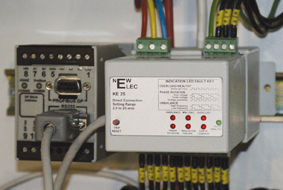
Contact Details:
NewElec (Pty) Ltd
298 Soutter Street cnr Maltzan Street
Pretoria West
Pretoria
0058
South Africa
Tel: +27 (0)12 327 1729
Alt. Tel: 0860 103 041
Fax: +27 (0)12 327 1733
Send Enquiry | Company Information

MOTOR MANAGEMENT AND PROTECTION IDEAS FROM NEWELEC
Product News Friday, November 9, 2012: NewElec (Pty) Ltd
Modern electronic motor protection relays can be used to access information relating to the operation of electric motors.
The KE and NewCode models from NewElec store up to 2 000 time stamped events and 60 fault conditions with all pertinent data in separate files for easy user inspection. The relays can also provide information on apparent power versus real power consumption of the motor. This information is stored in a rotating buffer. In addition, the new generation relays are aimed to be extremely user-friendly and provide new protection features usually not found in competing products.
The relay’s advanced features include patented vectorial stall detection that allows faster tripping of the motor on start stall. The dry run protection allows for priming time and time to trip with optional timed automatic re-set and re-start providing easy control of sump pump operation.
Selectable instantaneous or IDMT earth leakage tripping curves with user-selectable sensitivities with harmonic filtering ensure improved safety, reliability and equipment protection, not to mention space saving. The relay’s settings and information are accessible by means of an infrared device which improves safety, as there is no need to open the MCC doors.
With the earth insulation lockout feature the motor is shielded from being started when its winding insulation level is below a set threshold. Multi protocol compatibility caters for Profibus, Modbus and Canbus protocols.
LED indications for all faults and I/Os ensure ease in commissioning and fault finding. The removable memory module stores all current relay settings and addresses, making replacing a faulty relay and pararamatizing it quick and easy.
The relays can accommodate expansion modules, cater for RDT inputs and include 4 to 20 mA ‘in’ and ‘out’ analogue signals.
